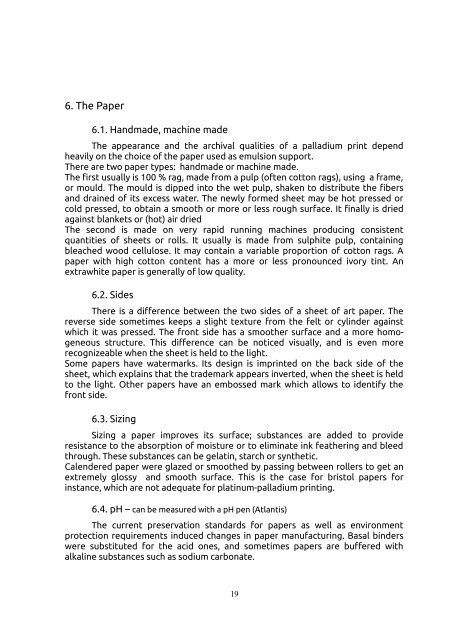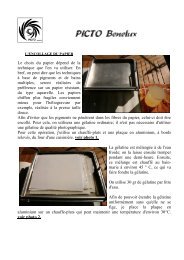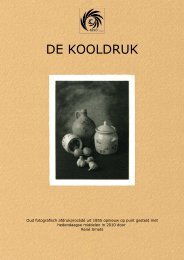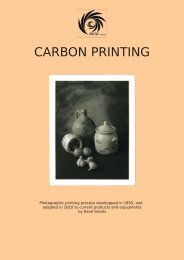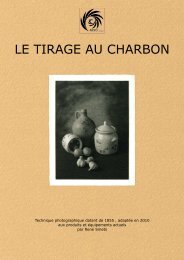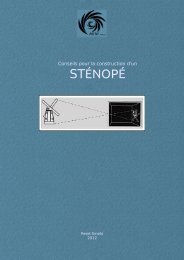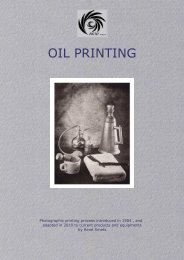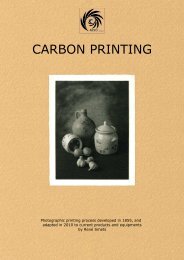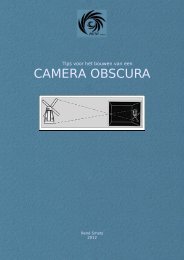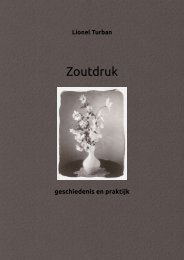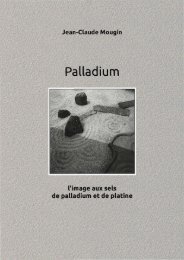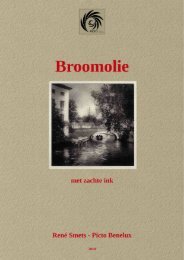Jean-Claude Mougin (pdf) - Picto Benelux
Jean-Claude Mougin (pdf) - Picto Benelux
Jean-Claude Mougin (pdf) - Picto Benelux
You also want an ePaper? Increase the reach of your titles
YUMPU automatically turns print PDFs into web optimized ePapers that Google loves.
6. The Paper<br />
6.1. Handmade, machine made<br />
The appearance and the archival qualities of a palladium print depend<br />
heavily on the choice of the paper used as emulsion support.<br />
There are two paper types: handmade or machine made.<br />
The first usually is 100 % rag, made from a pulp (often cotton rags), using a frame,<br />
or mould. The mould is dipped into the wet pulp, shaken to distribute the fibers<br />
and drained of its excess water. The newly formed sheet may be hot pressed or<br />
cold pressed, to obtain a smooth or more or less rough surface. It finally is dried<br />
against blankets or (hot) air dried<br />
The second is made on very rapid running machines producing consistent<br />
quantities of sheets or rolls. It usually is made from sulphite pulp, containing<br />
bleached wood cellulose. It may contain a variable proportion of cotton rags. A<br />
paper with high cotton content has a more or less pronounced ivory tint. An<br />
extrawhite paper is generally of low quality.<br />
6.2. Sides<br />
There is a difference between the two sides of a sheet of art paper. The<br />
reverse side sometimes keeps a slight texture from the felt or cylinder against<br />
which it was pressed. The front side has a smoother surface and a more homogeneous<br />
structure. This difference can be noticed visually, and is even more<br />
recognizeable when the sheet is held to the light.<br />
Some papers have watermarks. Its design is imprinted on the back side of the<br />
sheet, which explains that the trademark appears inverted, when the sheet is held<br />
to the light. Other papers have an embossed mark which allows to identify the<br />
front side.<br />
6.3. Sizing<br />
Sizing a paper improves its surface; substances are added to provide<br />
resistance to the absorption of moisture or to eliminate ink feathering and bleed<br />
through. These substances can be gelatin, starch or synthetic.<br />
Calendered paper were glazed or smoothed by passing between rollers to get an<br />
extremely glossy and smooth surface. This is the case for bristol papers for<br />
instance, which are not adequate for platinum-palladium printing.<br />
6.4. pH – can be measured with a pH pen (Atlantis)<br />
The current preservation standards for papers as well as environment<br />
protection requirements induced changes in paper manufacturing. Basal binders<br />
were substituted for the acid ones, and sometimes papers are buffered with<br />
alkaline substances such as sodium carbonate.<br />
19


